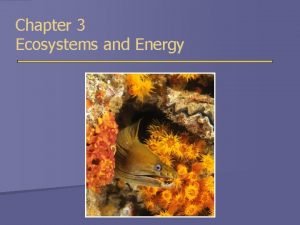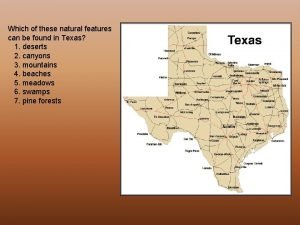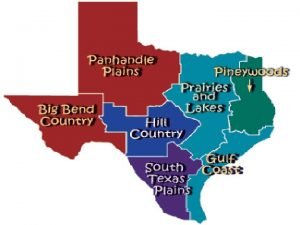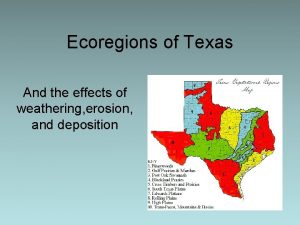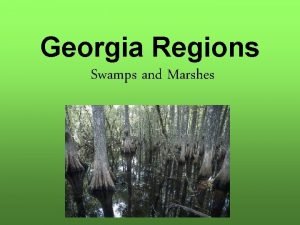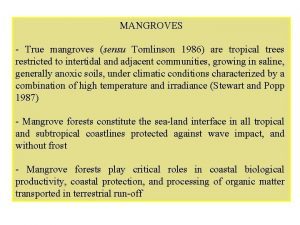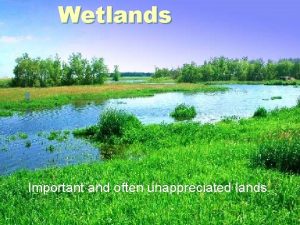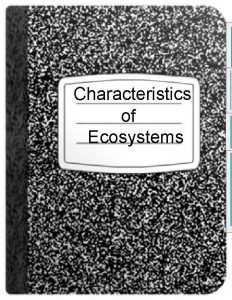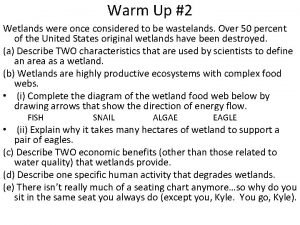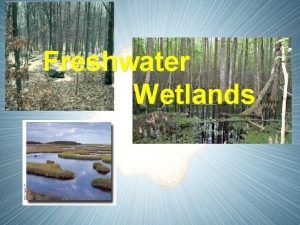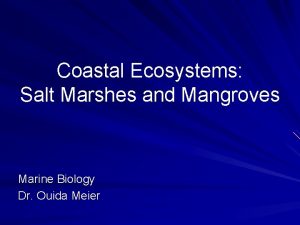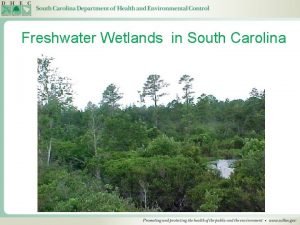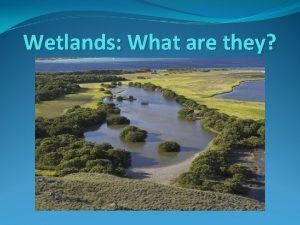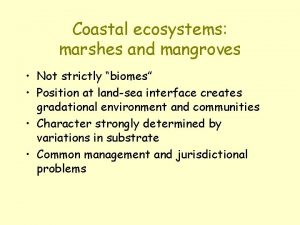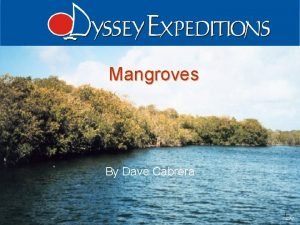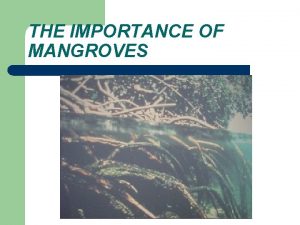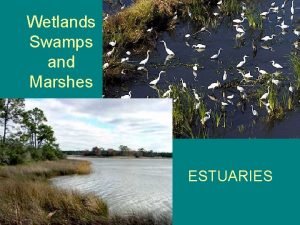Salt Marshes Mangroves and Wetlands Chapter 5 Salt












- Slides: 12

Salt Marshes, Mangroves and Wetlands Chapter 5

Salt marshes • Intertidal zone, emergent vegetation • • • Plants have adapted to saline soils, inundation Salt glands – salt on leaves of Spartina alterniflora High productivity in marsh due to sunlight Peat and sediment accumulation in soil Detritus production high - exported to estuary Habitat complexity is high (shoot density) - refuge from predation • Halophytes – salt-tolerant plants, 600 species in marsh worldwide • Species in NC: Spartina alterniflora, Spartina patens, Salicornia sp. , Juncus roemeranus, Distichilis spicata, Pluchea camphorata (Table 5. 1)

Mangroves • Mangrove – taxonomically, one of eight families of trees, salttolerant, 12 major genera worldwide. In Florida (USA): · Avicennia – black mangrove · Rhizophora – red mangrove · Laguncularia – white mangrove · All species grow in loose saline soils in intertidal environments. · "Mangrove" has also been used to describe the whole community of plants and animals where these trees are found (mangrove swamp or forest) · Viviparity – the "propagules" – not seeds, because inside the seeds have germinated already and are ready to sprout • Respiratory roots – pheumatophores stick up out of soil (Avicennia) or are on stilts (prop-roots) in Rhizophora

Latitudinal Zonation • Mangroves: • 29 ºN -- 29 ºS – tropics and subtropics · Mostly 25 ºN -- 25 ºS, but exceptions include: · Black mangroves scrub at 29 ºN (Dog Island, Florida) · 10 -15 ºfurther south in Africa, Australia · 7 º further north in Japan · Salt Marshes · From 25 º N -- 65 º N, and 35 º S -- 60 º S · 38 º N -- 65 º N – no above ground winter biomass due to ice scour · In southern hemisphere, only salt marshes in South America

Regional Zonation • Rainfall, ground water seepage may influence the type of marsh or mangrove found in a region. • Lots of rainfall = wide band of marsh or mangrove. As salinity decreases, the plant communities change, individual species vary in salinity tolerance • Mangroves – · Rhizophora, Avicennia, Laguncularia (in polyhaline areas) · Typha in oligohaline areas • Salt marshes · Species diversity declines with increased salinity • saline marsh: 6 species plants (Juncus, Spartina, Distichlis) • brackish marsh: 7 • fresh water marsh: 14

Elevation Effects • Different plants can tolerate different amounts of inundation (and salt content). • Salt Marsh – Spartina alterniflora – near edge, low elevation. – Juncus roemerianus – higher elevation – Panicum - highest elevation • Mangroves – Trees in mangroves. Rhizophora – Avicennia – Laguncumra

Succession in Marshes · Primary succession – S. alterniflora in SE marshes · In marshes in N. E. , after disturbance, succession: · Salicornia europea first to colonize (0 -2 yrs) · Distichlis spicata next to invade, vegetatively (2 -3 years) · Juncas or Spartina will out-compete Distichlis (3 -4 years) · Juncas or Spartina will dominate, but outcome depends on elevation. · climax – upland forest

Biological Interactions · Predation and competition may determine local patterns of abundance in both salt marshes and mangroves: • Juncus gerardi competitively excludes Spartina patens at high marsh/terrestrial zonation boundary. • Distichlis spicata is out-competed by both and is a disturbance fugitive species) (Bertness 1991) Ecology 72: 125 -137 Smith (1987) transplanted propagules of 4 species of mangroves in Australia (high intertidal – high salt, low inundation; low intertidal – low salt, high inundation). Transplanted to zone that was not its "normal" zone – it was zonedominated by Rhizophora racemosa. Although growth and survivorship was greatest in high intertidal, number of individuals was greatest in low intertidal. • • •

Marsh Zonation - caused by physiology? · Physiological tolerance model not supported by field studies. • Lab studies suggest that there are opportunities for growth • Multi-factorial experiments on mangroves in which salinity, p. H, redox, soil characteristics, etc. are varied have not been completed • Some support indicated – more data needed

Mangrove Zonation • Tidal Sorting hypothesis – large propagules not able to be transported to high intertidal, but take root in low intertidal, high inundation. – Small propagules are not transported to all intertidal areas. • Rhizophora propagules are large and this tree is found in low intertidal; • Avicenna propagules are smaller and found in high intertidal as well as low. • Unfortunately, there are other examples which suggest the opposite is true • This hypothesis not supported by data in literature

Mangrove Seed Predation · Crabs eat many propagules, graspid crabs in particular. · Smith (1987, 1988) tethered propagules across intertidal in Australia. • Found inverse relationship between predation rate on propagules and adults in canopy • When protected by cages from crabs, Avicennia propagules grew and survived in areas where adults not normally found • Seed predation probably important!

Competition in Marshes and Mangroves • Mangroves: Smith (1988) tested competition for Ceriops. – C. tagal and C. australis were grown in mono and polycultures in salinities 0 -60%. – C. tagal grew better than C. australis at low salinities. – C. australis grew better than C. tagal at high salinities. • Marshes: Bertness & Shumway (1993) – experimentally created bare patches followed succession over four years in a Juncus dominated and Spartina dominated zone – When Spartina removed, Distichlis % cover increases – Spartina % cover is the same, whether Distichlis is removed or not – In high marsh, salt stress inhibits recolonization by Juncus grows back more slowly with other species removed in the unwatered plots. – Removal of other species improves growth of Juncus with the watering and lowering of salt stress. – Alleviating salt stress shifted the nature of interspecific interactions from facilitative to competitive.
 Salt marsh decomposers
Salt marsh decomposers Coastal sand plains
Coastal sand plains Piney woods average temperature
Piney woods average temperature Edwards plateau weathering erosion deposition
Edwards plateau weathering erosion deposition Georgia swamp and marsh region
Georgia swamp and marsh region Introduction of mangroves
Introduction of mangroves Mediterranean forest
Mediterranean forest True mangroves
True mangroves Why are wetlands important
Why are wetlands important Climate of freshwater wetlands
Climate of freshwater wetlands Bill nye rivers and streams
Bill nye rivers and streams Wetlands were once considered to be wastelands
Wetlands were once considered to be wastelands Wetland ecosystem definition
Wetland ecosystem definition
